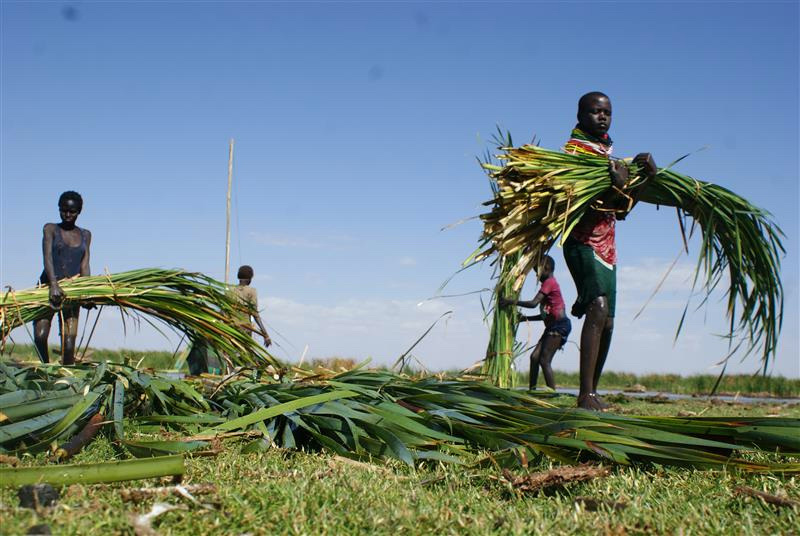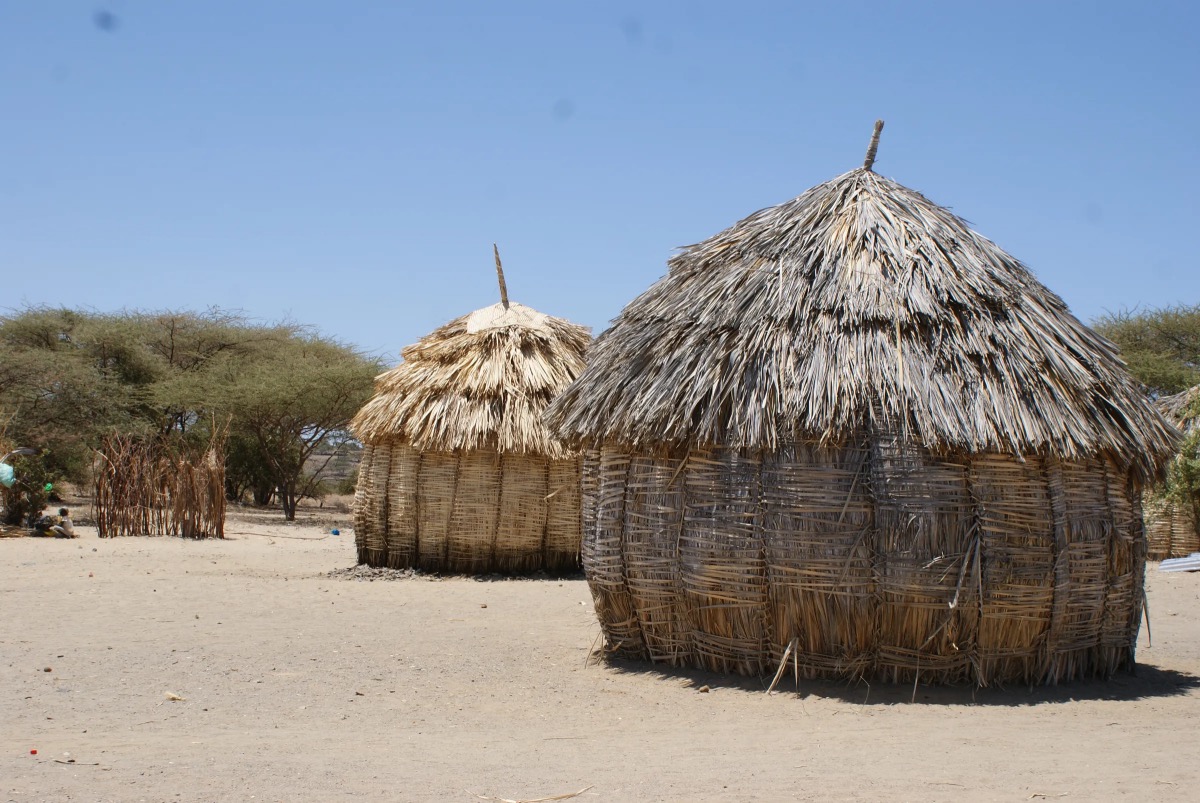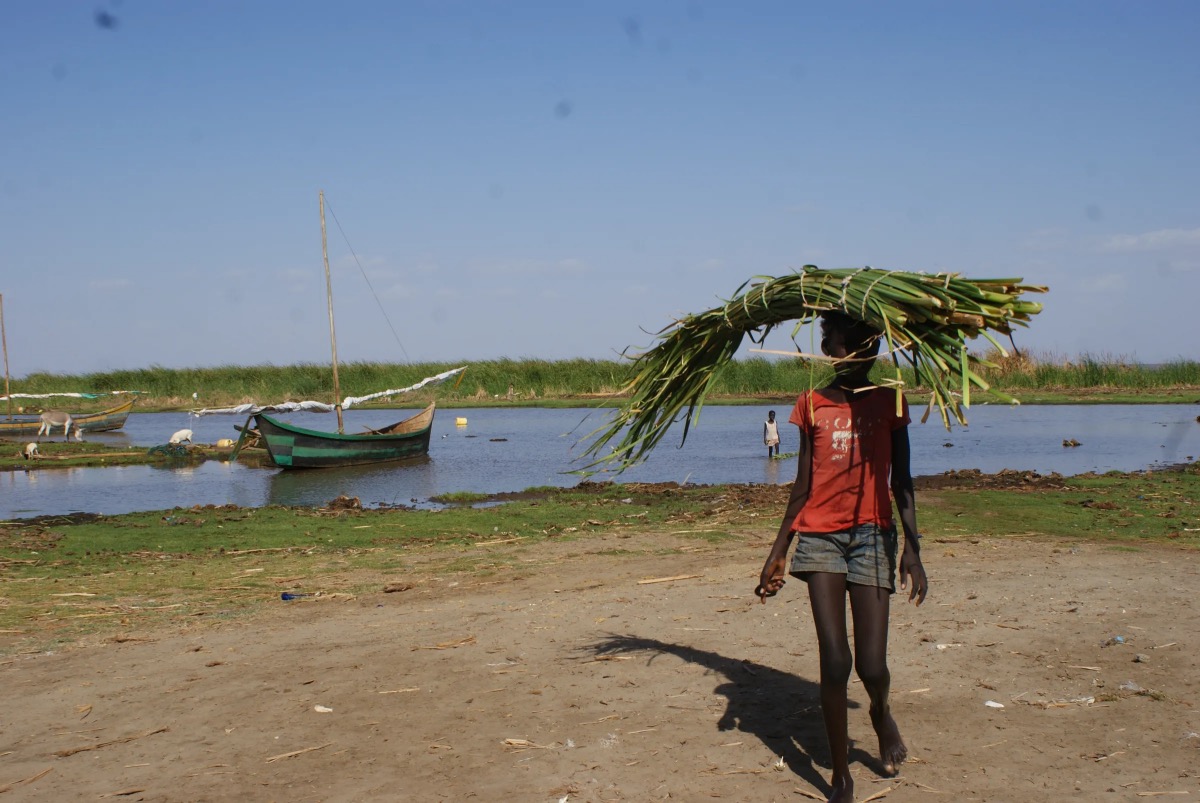
KAGONDU NJAGI, of Thomson Reuters Foundation, reports on how communities in Kenya are reverting to thatched roofs to stay cool amid worsening heatwaves fuelled by climate change…
Katilu, Kenya
Thomson Reuters Foundation
For Kenyan schoolteacher Simon Ewoi, having an iron-sheet roof on his house has been a source of pride – and a symbol of prosperity – in a village where thatched-grass roofs are the norm.
But about a decade after he built his home in Turkana county, Ewoi recently constructed a new building on his compound – this time reverting to a grass roof to try to cope with rising temperatures fuelled by climate change.
“Traditionally thatched houses are cooler than those roofed with iron sheets,” the 37-year-old said in an interview.
“It is becoming necessary to have this additional house…to shelter away from rising heat,” he added.

People carry harvested water reeds in Kanamukuny village, northern Kenya, on 19th September. PICTURE: Thomson Reuters Foundation/Kagondu Njagi
Temperatures in Kenya have risen by 0.3 degrees Celsius per decade since 1985, and a report last year by the charity Christian Aid said that the country’s average annual temperature could increase by up to 2.5 degrees C between 2000 and 2050.
Kenya’s meteorological department said more and more arid regions like Turkana are experiencing heatwaves where temperatures of 46 degrees Celsius or higher last for two or three days.
“Sometimes when we are faced with challenges in life, we go back to the old ways of living.”
– Fiona Mwaniki, a researcher at the Kilimo Media International.
Patricia Nyingúro, a climate scientist at the department, said her team had recorded such heatwaves occurring both in arid northern Kenya and the country’s coastal belt in recent years, warning of growing risks from such “climate shocks”.
To withstand the withering heat, many people in rural communities are now replacing or supplementing iron-roofed homes with buildings thatched with grass, palm fronds or water reeds, according to civil society groups and local leaders.
We rely on our readers to fund Sight's work - become a financial supporter today!
For more information, head to our Subscriber's page.
While there are some concerns about their long-term suitability, experts said indigenous knowledge on how to deal with climate change pressures – including heat stress – should be given space in adaption planning efforts.
“Sometimes when we are faced with challenges in life, we go back to the old ways of living,” said Fiona Mwaniki, a researcher at the Kilimo Media International, an agricultural advisory NGO.
“Marginalised people have to make do with what they have,” said Mwaniki, who has done research into indigenous climate change adaptation systems.
Sarah Murabula Achola, a Kenyan researcher and climate expert at Germany’s University of Kassel, agreed that the “merits of indigenous or local knowledge cannot and should not be overlooked” in climate change adaption efforts.

Thatched-roof houses stand in Kanamukuny village, northern Kenya, on 19th September. PICTURE: Thomson Reuters Foundation/Kagondu Njagi
There is no recent data on how many Kenyans have thatched-roof homes, but a 2003 government demographic and health survey found that about 22 per cent of the population did then. Activists said the proportion is unlikely to have changed much since.
“Traditional thatching is an accepted way of having cool houses,” said Bonface Ewaar, a youth leader in Katilu.
“It is cheap because the materials to build are locally available,” he said, adding that rural communities cannot generally afford air conditioning due to high poverty levels and lack of access to electricity.
Like Ewoi, Joyce Lokalel, a mother-of-four in Katilu, built an iron-roofed home in 2013 but recently constructed another house with traditional thatching to try to escape the heat.
Thatched houses are vital for pregnant mothers who may need to rest during the day, as well as babies and infants, she said.
However, the 31-year-old – who owns a farm near the village – said she felt increasingly helpless battling the “double shock” of heat stress and drought.
Kenya is enduring its worst drought in 40 years, which has killed livestock and crops in some regions and is provoking a deepening hunger crisis.
“This heat comes at a time when I need to work harder… but now I do nothing most hours of the day,” Lokalel added.
James Lobeck, chairman of the charity Sustainable Approaches for Community Empowerment, said he had noticed a sizeable increase in the number of thatched-roof houses being built in poorer areas of Turkana county in recent years.
“I think having thatched houses works well for these communities because most are too poor to afford modern cooling systems, even those powered by solar energy,” he said.
“In most of these regions there is no electricity connectivity,” Lobeck added.

People carry harvested reeds in Kanamukuny village, northern Kenya, on 19th September. PICTURE: Thomson Reuters Foundation/Kagondu Njagi
Traditional thatched roofs can help battle heat but need more frequent replacing than iron roofs and cannot withstand prolonged rains or strong winds, as well as being vulnerable to fire, Lobeck warned.
Communities and campaigners including Nyang’ori Ohenjo, chief executive of the NGO Center for Minority Rights and Development, say more accurate weather forecasts will also be key to help people prepare for rising temperatures and heatwaves.
A combination of modern satellite-based weather prediction and trusted traditional weather prediction systems would work best, Ohenjo said.
According to a 2020 study published in the scientific journal Atmosphere, lethal heatwaves are at risk of becoming a normal occurrence around much of the globe within 20 years.
Peter Ektela, a local leader in Katilu, said his community is already facing the threat, struggling to work and raise food in the face of not just drought but worsening heat that requires families to take shelter.
“I am already weak due to the prolonged drought that has hit us – and now I am faced with the risk of heat stress,” he said, calling for government social welfare programmes to help people deal with worsening climate change impacts, including heat.






